The unbreakable DNA weathers threats
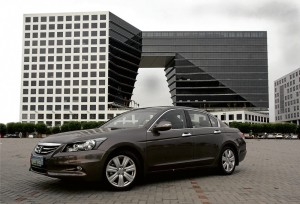
MORE PREMIUM ON PREMIUM. The 2012 Accord—Honda’s premium sedan is no longer alone in its segment as two more vehicles join the class: The new Pilot (SUV), and the Odyssey (mini-van). PHOTOS BY EUGENE ARANETA
In 2004, the worldwide Ethical Consumer Research Association ranked car companies in order of their “green” credentials, basing their rating on 16 criteria (encompassing environment responsibility, safety and concern for human rights and animal welfare). Honda was ranked the eighth brand that attracted the least number of criticisms.
And as documented in the book “Chapman’s Car Compendium,” the Honda brand has also been “quietly” gathering honors and distinction around the world, having, for instance, the most number of Car of the Year awards from North America (Car of the Year, Truck of the Year), to hometown Japan.
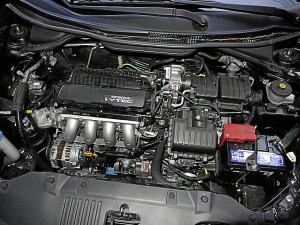
THE NEW City is equipped with the i-VTEC engine, which regulates the opening of the air-fuel intake valves and exhaust valves in accordance with engine speeds.
The feat is made doubly remarkable, what with Honda being battered by two natural disasters in recent years (the earthquake and tsunami in Japan, and the flooding in Thailand) that took a toll on its supply chain, and an all-too-real cutthroat competition posed by gung-ho Korean brands.
Despite the temptation to do things “the easy way,” Honda Cars Philippines Inc. has stuck to its corporate values, as exemplified by its policy of publicly announcing recalls (for even such mundane reasons as replacing potentially faulty power window master switch assemblies). At a time when “silent recalls” have been the norm, and public ones considered “brand suicide,” HCPI was able to get the message across: Hide the wound, and run the risk of it festering. But expose it to the open, and the wound may dry up and heal more quickly. Public recalls eventually pumped up consumer confidence in the brand, as the company showed it placed the safety and welfare of its customers on top of its priorities.
Its other proconsumer practices include “Be Smart, Test Drive” campaign, which made its lineup of products Jazz, City, Civic, and CR-V available for test drive in all of its 28 dealerships. Its Honda Challenge Cup in 2010, on the other hand, taught participants fuel-efficiency techniques using the City, Jazz, Civic, CR-V and Accord.
Article continues after this advertisement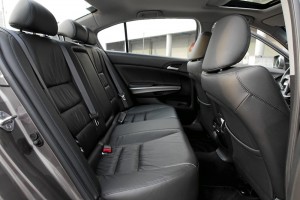
THE ACCORD’S long history and excellent track record in the Philippine automotive market still guarantees its place among the top-of-mind models in its category.
Last year, due to the effects of the Japan earthquake and the flooding in Thailand, Honda’s presence in the Philippine market dipped. HCPI has recovered from that, however, and now offers a steady supply of vehicles. In January this year, HCPI introduced a new City with minor model changes, a full-model change Civic and CR-V, the Jazz special edition, and upscale vehicles—the new Pilot and Odyssey. Just this Monday, it launched new variants that completed its Civic line-up: The Civic 1.8 S (manual and automatic transmissions); 1.8E (A/T) and 2.0-liter EL (A/T). HCPI’s current model is 1.8 EXi (A/T).
Article continues after this advertisementJust like that, Honda’s troubles seemed so last year—a distant memory.
Honda can be said to be addressing an evolving automotive landscape—a landscape that includes aggressive Korean brands, which attract new buyers and which polarizes the market. Honda has paid special attention to its Korean counterparts because much of the competition’s personality has been somewhat derived from Honda’s own DNA of fun-to-drive, fuel-efficient and daringly styled vehicles.
Appreciative. This was the word running in my mind when, sometime in May, I had taken two of Honda’s iconic vehicles out on a spin. These two were as far apart from Honda’s production lines as they could be: One was its most premium vehicle, the other was its most affordable.
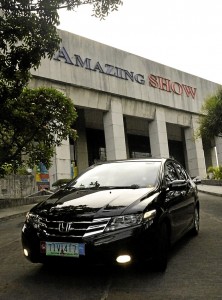
THE DESIGN inspiration of the new City is the “arrowshot” form, which highlights the “strength” and “momentum” of the design. The City has five-speed automatic transmission that also contributes to improved driving feel and fuel efficiency.
Nevertheless, I experienced firsthand the Honda DNA in both sedans, and as soon as I sat on the driver’s seat, I appreciated what Honda had gone through to still wake up from its nightmares as fresh-smelling as the cabin of a brand-new car.
The Accord is Honda’s premium sedan in the Philippines, and has been positioned to appeal to corporate executives and business entrepreneurs mostly in their 30s and 40s. The Accord’s driving performance and comfort have been engineered and designed to match the stature of its passengers.
The Accord underwent a product refresh in May 2011, and despite showing lower sales as of latest count this year compared to last year, the Accord’s long history and excellent track record in the Philippine automotive market still guarantees it a place among the top-of-mind models in its category.
The City, which is currently the most affordable sedan in the Honda model line-up, has been positioned in the sub-compact sedan category. It underwent its own reboot with the introduction of the new 2012 City last January. After four model launches since its birth in 2009, the City’s sales volume this year still puts it among the top-selling sedans in its category. While competitor models receive a significant boost with taxi fleet sales, the City has relied solely on individual customers, and still is able to capture a significant share in its market category.
Just like its snazzier sister Jazz, the City has powerful yet fuel-efficient engines (1.3- and 1.5-liter variants), compact body size yet spacious interior. It appeals to both single car and multiple car households. The City appeals to customers of a wide age range. The Jazz comes up a notch higher in styling and cargo versatility, with its sportier design and ULT [Utility, Tall, Long] mode seats, thereby attracting the younger, more active market in their 20s. In terms of sales, however, the City outdoes the Jazz 5 to 1.
Strong on-road presence
The Accord presents itself rather boldly. The bold chrome grille, the tail lights with the trunk garnish at the rear, and the striking side lines give the Accord that aggressive presence.
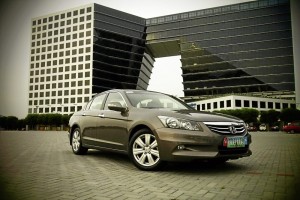
THE “H” logo has stuck to its theme since 1962, according to historians of “Car Badges.” The logo is prominent in the 2012 Accord, Honda’s premium mid-sized sedan, which won for HCPI the 2004 Car of the Year-Philippines (the first local Coty award given to a car). PHOTOS BY EUGENE ARANETA
The design inspiration for the new City is the arrowshot form, which highlights both the “Strength” and “Momentum” of the design. With the leading edge—the front—of the new City accented with chrome in the front grille, the new City’s totally overhauled look has been well received by the market.
Drive-by-wire
Notable with all Honda models nowadays is that they are equipped with Drive-By-Wire (DBW) throttle control. The DBW replaces the cable connecting the accelerator pedal to the throttle of the engine with computer sensors. These sensors now more accurately deliver the right amount of fuel for a given demand.
The new City is equipped with the i-VTEC engine for both 1.3- and 1.5-liter variants, compared to the previous-generation City, which was equipped with the i-DSI engine. i-VTEC produces more power and torque output. At the same time, the i-VTEC engine regulates the opening of the air-fuel intake valves and exhaust valves in accordance with engine speeds. This allows the i-VTEC engine to achieve optimal power and excellent fuel efficiency.
The five-speed automatic transmission of the City also contributes to the improved driving feel and fuel efficiency.
The Accord, which won the 2004 Car of the Year-Philippines (the first local award given to a car), still brings with it the confident ride quality, now enhanced by various features such as a highly rigid body construction and four-wheel independent suspension, and DBW throttle.
The Vehicle Stability Assist (VSA), the traction control technology of Honda, is a safety feature designed to help the driver maintain control of the vehicle while cornering. During understeering or oversteering, the VSA can apply the brakes on individual wheels and/or reduce engine power to help restore the intended driving direction of the vehicle.
The Accord has a four-wheel independent suspension with double wishbone front suspension and multi-link rear suspension that provides a smooth and stable ride. It is also equipped with VGR, or the Variable Gear Ratio steering system, as well as Gear Shift Management Control. VGR helps ensure the Accord’s maneuverability despite its large dimensions by minimizing steering input, without any compromise to accuracy or feel.
The Gear Shift Management Control, on the other hand, lessens unnecessary shifting or gear hunting, especially when traversing curvy roads. This leads to a sportier and much smoother drive.
Both Accord variants are equipped with engines that are more than capable in terms of pulling power. The Accord 2.4 S is equipped with a 2.4-liter DOHC i-VTEC in-line four cylinder engine with a power rating of 180 ps @ 6,500 rpm, and a maximum torque rating of 22.6 kg-m @ 4,300 rpm.
The top-of-the-line variant of the Accord is the 3.5 SV that comes equipped with a 3.5-liter V6 engine with a power rating of 275 ps @ 6,200 rpm and a torque rating of 34.6 kg-m @ 5,000 rpm.
The 3.5-liter V6 variant is equipped with the Variable Cylinder Management (VCM), which contributes to improved fuel consumption without sacrificing power when needed. It does this by deactivating two- to three-engine cylinders depending on the driving conditions. When maximum torque is needed, all six cylinders of the engine are activated.
During steady cruising speeds, two to three cylinders are deactivated to improve fuel economy.